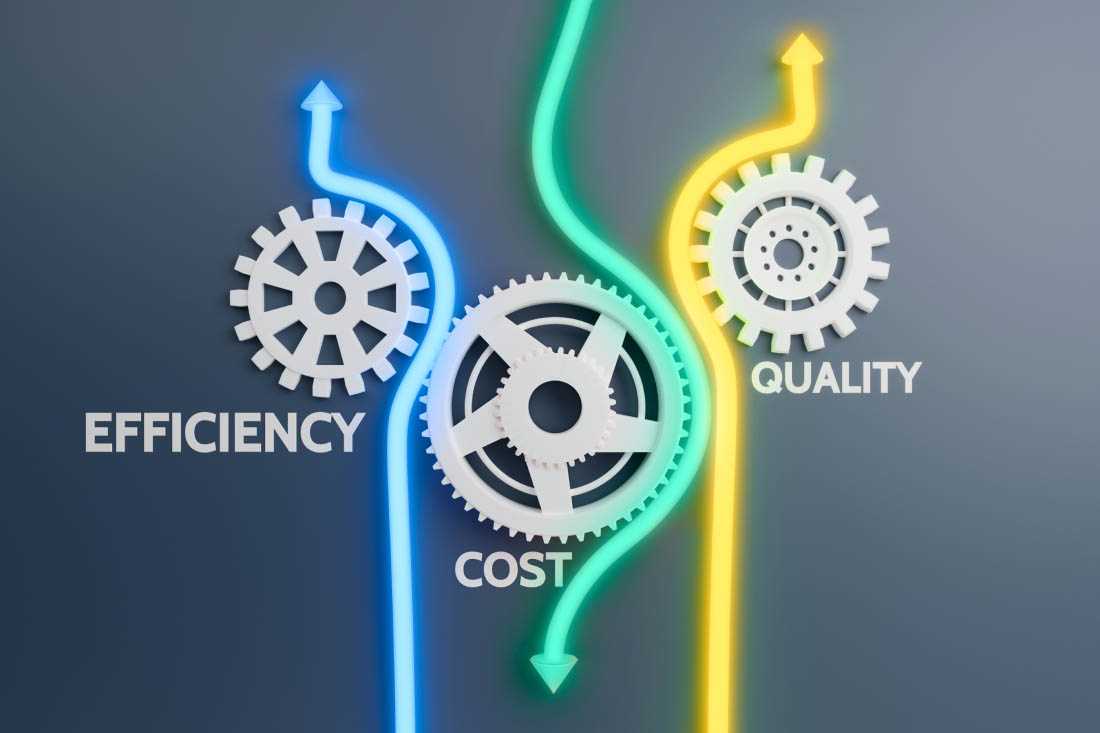Productivity is a key metric for organizations that want to stay competitive today. Empowering employees to accomplish their work in a timely manner means an organization saves on resources, time and money. At the same time, companies need employees to produce high-quality work or they’ll face poor customer service scores and the frustration of having employees redo work. Productivity and quality of work go hand-in-hand to ensure an organization meets its goals, but many leaders aren’t aware of how boosting one can improve the other.
Find out how increasing productivity in your organization leads to better work quality, including common challenges to aligning quality, the differences between productivity vs. efficiency and how leadership impacts work quality and productivity.
Defining productivity and quality of work
Productivity is a metric that determines how efficiently employees or teams finish work or attain goals. The concept of productivity encompasses how much work an individual, team or department completes in a given timeframe, how often they meet deadlines and how much effort or resources they need to complete their tasks.
Quality of work is the measure of how good the work is once it’s completed. This is relatively straightforward in manufacturing or goods-based industries because it’s easy to judge if a product meets standards. However, there are many other markers of quality work, such as attention to detail, standard of work and exceeding expectations.
It’s important to note that productivity and efficiency are often confused. While they are related, there are different metrics required to measure them. Both productivity and efficiency are important indicators of an organization’s capabilities, competitiveness and overall effectiveness.
How quality of work connects to productivity
Work quality and productivity are closely related. For employees to deliver high quality work, they need many of the same factors they need to be productive: a supportive and focused work environment, metrics to measure work performance and effective communication across the organization. Improving productivity gives employees more time and mental bandwidth to focus effectively on creating quality work.
Unfortunately many organizations focus on productivity at the expense of work quality. When managers are too focused on how much completed work team members achieve in a set amount of time, they may create a culture where employees want to “look busy” rather than complete work up to a set standard. Similarly, employers may lose quality by pushing employees to hit unattainable productivity goals. For example, if a workplace decides to reduce headcount but continues to ask employees to maintain the same level of output, work quality and job satisfaction are both likely to decrease, which will impact productivity for everyone.
Productivity vs. efficiency and how it impacts quality of work
It’s important to note efficiency’s impacts on work quality, as well. While productivity tends to focus on how much time employees spend on productive activities, efficiency focuses on how they use resources to accomplish tasks. Many organizations will focus on efficiency as a way to cut costs by reducing waste, but this can make work quality suffer.
By empowering employees to work both more productively and more efficiently, organizations see benefits such as:
- More effective planning and prioritization
- Better focus on projects and tasks
- Less rushing, fewer mistakes and less time spent doing tasks again
- Improved quality assurance processes
- More creative problem solving
- Higher job satisfaction and employee engagement
Leadership styles and their impact on productivity and work quality
Leadership has a profound impact on productivity levels and work quality. Different styles of leadership lead to different outcomes, and every organization needs the right leadership to accomplish goals. Consider the differences between transformational leadership and transactional leadership:
| Transformational leadership | Transactional leadership | ||
| Pros | Cons | Pros | Cons |
| Encourages innovation and creativity for groundbreaking solutions | Reduces ability to achieve short-term goals or focus | Focuses on routines and structure | Overemphasizes how work is done rather than quality |
| Empowers autonomy | Can create dependence on the leader | Emphasizes deadlines and goals | Stifles creativity and individual problem solving |
| Champions risk-taking | Opens the organization up to bad decisions or blindly following ideas | Champions clear communication of processes | May encourage micromanagement, lack of trust and disengagement |
| Prioritizes collaboration | May encourage too many meetings or reduce focus time | Provides direct feedback | May alienate employees who need coaching and guidance |
| Emphasizes personal growth | Increases the risk of burnout for employees | Enhances efficiency | May sacrifice collaboration and create a stressful environment |
Leaders need to be aware of their leadership styles and how they impact company culture to improve or reduce productivity and work quality.
Challenges aligning productivity with high-quality work
Balancing productivity and quality of work is often tricky for organizations. Some common challenges to aligning the two include:
Focusing solely on productivity
While improving productivity clearly opens up opportunities to improve work quality, focusing solely on how much work employees produce leads to several problems. When employees rush to finish work, they’re less likely to take the time to ensure the output meets quality standards. Focusing on productivity also diminishes attention to detail and can create a culture of lower standards for work.
Workplace challenges
Employees often face a number of challenges that create obstacles to aligning productivity and high-quality work, such as struggles with time management, unclear expectations and poor communication skills.
Poor work environment
The work environment has a profound impact on both productivity and work quality. Distractions, stress and low morale all contribute to poor job performance and lower team collaboration.
Productivity vs. efficiency: Understanding the metrics and KPIs that matter
To effectively measure efficiency and productivity in the workplace, organizations must establish key performance indicators (KPIs) that make sense. With productivity, organizations look at how much work individuals or teams accomplish in a set timeframe. With efficiency, organizations look at how well employees complete work using the smallest amount of resources.
For example, consider two employees working in a customer solutions call center, Jane and John. If Jane takes 30 calls in two hours and John takes 20 calls, Jane is more productive than John. However, if Jane has to escalate 15 calls to another department and John is able to solve the customer issues with only five escalations, John is more efficient than Jane.
Some KPIs organizations should watch to measure productivity include:
- Productive hours per day
- Productive time vs. overall time
- Average daily productivity
Organizations should measure these KPIs for efficiency:
- Error rate
- Revenue per employee
- Goal attainment rate
Measuring and improving both productivity and efficiency leads to better outcomes in work quality.
Strategies for boosting productivity without compromising quality
Removing barriers to productivity or equipping employees to be more productive improves work quality. Implementing the following
- Establish clear goals and objectives: When employees know what they’re working towards and why, they’re more likely to focus on hitting those goals. This empowers team members to prioritize work that accomplishes goals to better hit deadlines and produce quality work. Research has shown that establishing clear goals leads to up to 90% better performance for employees.
- Prioritize straightforward communication: Organizations must work to ensure employees understand their tasks, roles, goals, responsibilities and how all of these align with the overall company mission. Consistent, clear communication is the best way to ensure everyone is on the same page. Team members must also have effective ways to communicate with each other to accomplish tasks, establish accountability and be productive.
- Offer frequent training and development: By upskilling, employees become better at doing their work, which means higher quality and higher productivity.
- Provide appropriate collaboration tools: Productivity hinges on employees’ ability to work together effectively. The right collaboration tools like cloud-based file sharing, project management software and effective meeting policies empower employees to work together without hindering focus time. According to B2B Reviews, collaborative workplaces are 30% more productive than less collaborative ones.
- Empower a productive work environment: Providing employees with a work environment where they can focus empowers them to complete tasks on time and at a higher quality level. This means reducing distractions in the workplace and providing safe, comfortable working conditions, whether employees are working in an office or remotely.
- Give timely feedback: Managers and supervisors must communicate to their employees their job performance, including whether they’re on target to meet goals or if they’re falling behind. At the same time, employees need a regular place to give feedback on their work performance and how processes or policies affect them. Regular performance reviews, anonymous surveys and one-on-one meetings are great ways to empower employees to show initiative and find innovative solutions to their productivity.
- Enhance effective time management: Employees who manage their time effectively are less stressed, more productive and more capable of producing quality work. According to Zippia, fewer than one in five workers has an effective time management system. Organizations that empower employees to manage their time effectively see reduced waste, better job satisfaction and increased productivity and quality of work.
- Champion efficient work processes: Similar to effective time management, creating and championing efficient work processes empowers employees to be more productive and produce higher-quality work.
Enhance productivity and quality of work across your teams with ActivTrak
Finding the right tools to measure and improve productivity, efficiency and quality is a top priority for organizations looking to achieve their goals. ActivTrak offers a comprehensive workforce analytics cloud that revolutionizes the way you understand your team’s productivity and work quality. Our solutions will:
- Will give your organization visibility into real-time productivity metrics like total and productive time, application and tool usage and goal completion with employee productivity monitoring.
- Spot inefficiencies and compare how much time individuals spend collaborating or focusing on individual tasks to improve processes.
- Empower teams and employees to make informed decisions around when, how and where work gets done based on trends and real-time data.
Join the 9,500+ customers who trust ActivTrak’s award-winning solutions to elevate their productivity, efficiency and work quality. Contact our sales team today to get started.





